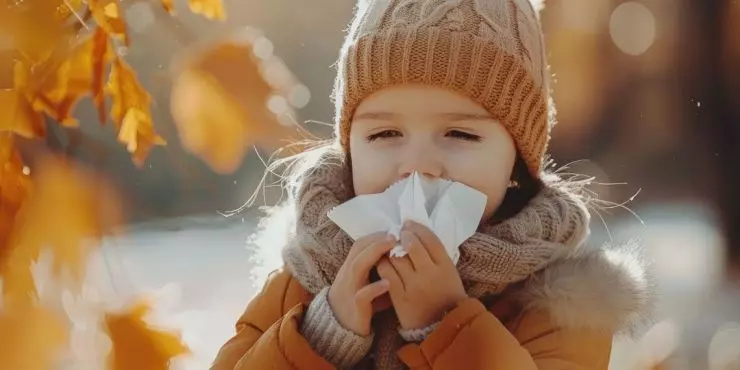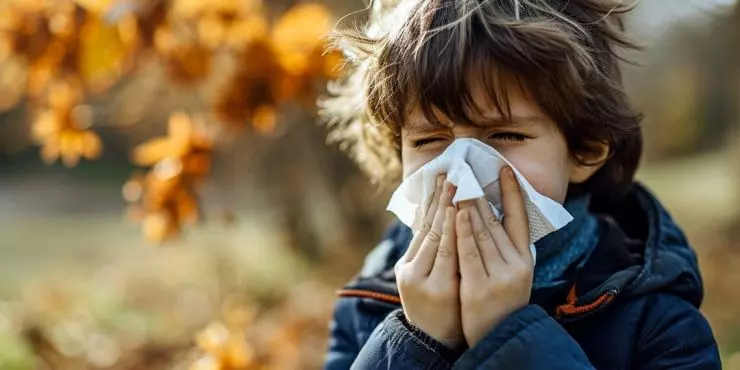Just when you’ve packed away the beach towels and embraced sweater weather, the sniffles start. But it’s not a cold—it's fall allergies. If your child suddenly seems stuffy, sneezy, or extra tired when school starts, ragweed, mold, or classroom allergens might be to blame.
At Northwest Family Clinics, we see a surge in allergy symptoms every fall—especially among school-age kids and teens. Here's how to tell if allergies are the culprit, what you can do about them, and when to check in with your doctor.
Why Are Fall Allergies So Common?

Fall allergies are triggered by seasonal changes in plants, weather, and indoor environments. The most common culprits?
- Ragweed: One of the biggest triggers in the Midwest, this yellow-flowered plant releases pollen from August through October—and just one plant can produce up to a billion grains.
- Mold: As leaves pile up and decompose, mold thrives in the damp, cool weather. Mold spores can linger in the air and trigger reactions both indoors and out.
- Indoor Allergens: Once kids are back in school, they’re exposed to more dust mites, classroom pets, and poor indoor air circulation—especially in older buildings.
Fall Allergy Symptoms to Watch For
Fall allergies can look a lot like a common cold, especially in kids. But allergy symptoms tend to last longer and don’t come with a fever.
Common signs include:
- Sneezing
- Runny or stuffy nose
- Itchy, watery eyes
- Scratchy throat
- Coughing (especially at night)
- Dark circles under the eyes (“allergic shiners”)
- Fatigue or irritability
If your child has asthma, allergies can also trigger wheezing or breathing trouble.
Tips for Managing Fall Allergies

Managing allergies isn’t just about medication—it’s also about reducing exposure. Here are simple, practical ways to help your child feel better:
1. Track Pollen Counts
Check local pollen forecasts before planning outdoor activities. On high-ragweed days, try to limit early morning outdoor time when pollen is at its peak.
2. Change Clothes and Shower After Outdoor Play
Pollen and mold can stick to clothes and hair. A quick rinse and change after playing outside can reduce symptoms.
3. Keep Windows Closed
It’s tempting to open the windows when the weather cools down, but that lets pollen and mold inside. Use air conditioning or air purifiers with HEPA filters when possible.
4. Vacuum and Dust Frequently
Especially if you have pets or your child plays on the floor. Look for vacuum cleaners with HEPA filters to trap allergens.
5. Use Allergy Medications Preventively
If your child has seasonal allergies every year, start treatment before symptoms begin. Over-the-counter antihistamines, saline and steroid nasal sprays, or eye drops can be very effective—but talk to your provider about what’s safe and age-appropriate.
You can learn more about managing seasonal allergies here and some additional tips on naturally managing allergies here.
When to Talk to Your Doctor
If allergy symptoms are disrupting sleep, interfering with school, or causing asthma flare-ups, it’s time to check in. We can help determine what’s going on and recommend a treatment plan that works for your child’s needs.
You don’t have to guess your way through fall allergies—we’re here to help you get answers and relief.
FAQs About Fall Allergies

Q: How do I know if it’s a cold or allergies?
A: Colds typically last 7–10 days and often come with a fever, body aches, and thick mucus. Allergies last longer (sometimes weeks or months), don’t cause a fever, and often include itchy eyes or nose. You can learn more on how to tell if it’s allergies or something else here.
Q: Are allergy medications safe for kids?
A: Many over-the-counter allergy meds are safe for kids over age 2, but dosage matters. Always check with your doctor before starting a new medication—especially for younger children.
Q: Can my child develop allergies even if they’ve never had them before?
A: Yes. Seasonal allergies can appear at any age, though they’re most common in children over 3. If symptoms return around the same time each year, allergies may be the cause.
Q: Are fall allergies worse for kids with asthma?
A: They can be. Allergens like mold and ragweed may trigger asthma symptoms or make them worse. It’s important to have an updated asthma action plan and use preventive medication as prescribed.
Q: When should we consider seeing an allergy specialist?
A: If your child’s symptoms don’t improve with treatment, affect their daily activities, or you’re unsure of the triggers, we may refer you to a pediatric allergist for further testing and management.
Relief Is Possible—We’re Here to Help
Fall allergies can feel never-ending, but with the right care, your child doesn’t have to suffer through the season. From accurate diagnosis to personalized treatment plans, our team at Northwest Family Clinics can help your family breathe easier this fall.
If your child has symptoms that won’t go away—or if you’re unsure whether it’s allergies, a cold, or something else—book a visit with your provider today. We’re here to help your whole family feel their best all year round.
Three Locations Near You: Rogers, Plymouth, and Crystal
We're accepting new patients and offer same- and next-day appointments. Call today or book online to schedule your child’s visit.
Additional Articles You Might Like
Preventing Allergies in Children - How to Introduce High-Allergen Foods
Best Alternatives to Halloween Candy and Other Healthy Fall Treats
Spring Allergies in Kids: Symptoms, Treatment & Prevention